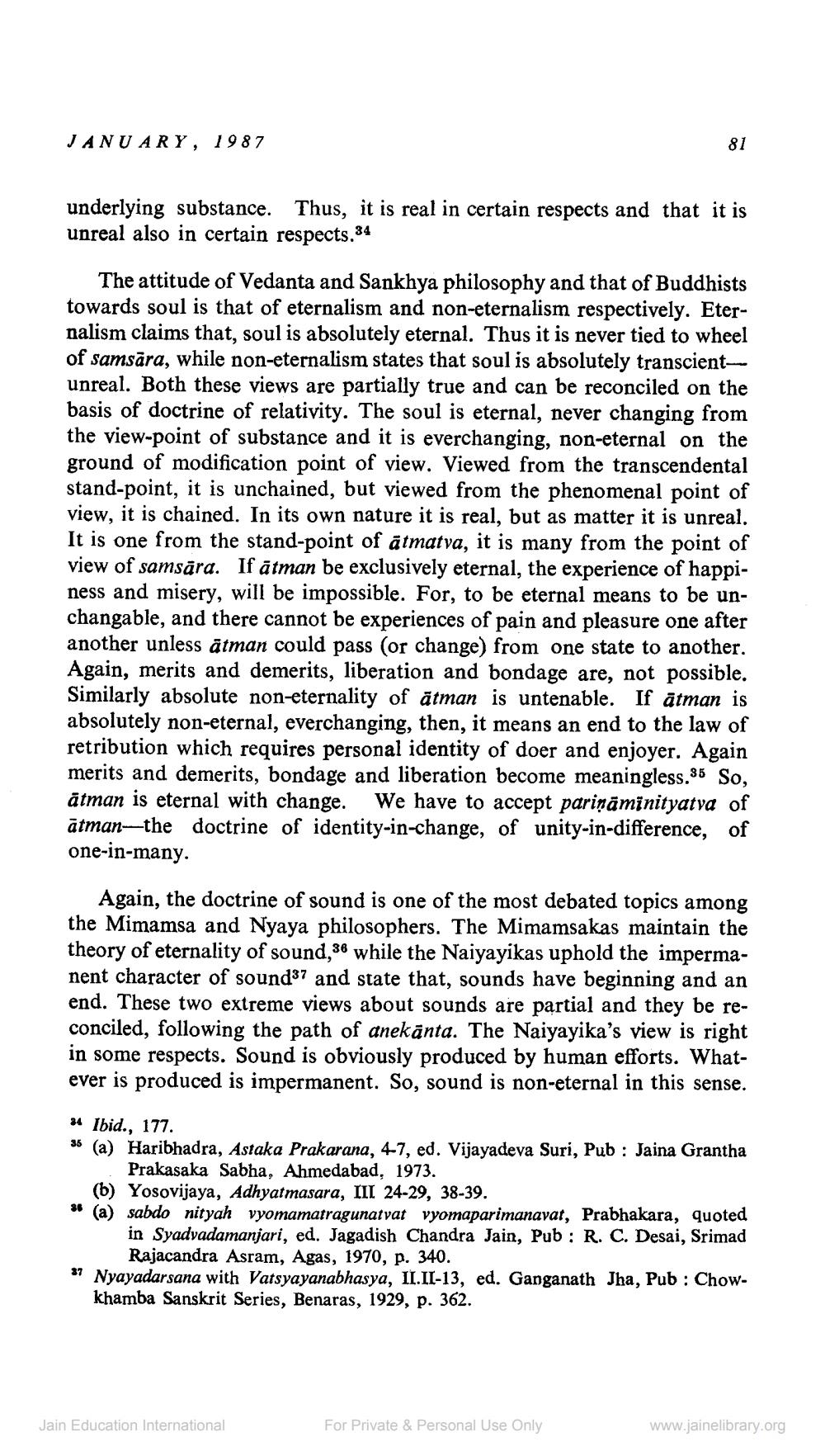________________
JANUARY, 1987
81
underlying substance. Thus, it is real in certain respects and that it is unreal also in certain respects.34
The attitude of Vedanta and Sankhya philosophy and that of Buddhists towards soul is that of eternalism and non-eternalism respectively. Eternalism claims that, soul is absolutely eternal. Thus it is never tied to wheel of samsāra, while non-eternalism states that soul is absolutely transcient unreal. Both these views are partially true and can be reconciled on the basis of doctrine of relativity. The soul is eternal, never changing from the view-point of substance and it is everchanging, non-eternal on the ground of modification point of view. Viewed from the transcendental stand-point, it is unchained, but viewed from the phenomenal point of view, it is chained. In its own nature it is real, but as matter it is unreal. It is one from the stand-point of ātmatva, it is many from the point of view of samsāra. If ātman be exclusively eternal, the experience of happiness and misery, will be impossible. For, to be eternal means to be unchangable, and there cannot be experiences of pain and pleasure one after another unless ātman could pass (or change) from one state to another. Again, merits and demerits, liberation and bondage are, not possible. Similarly absolute non-eternality of ātman is untenable. If ātman is absolutely non-eternal, everchanging, then, it means an end to the law of retribution which requires personal identity of doer and enjoyer. Again merits and demerits, bondage and liberation become meaningless.85 So, ātman is eternal with change. We have to accept pariņāminityatva of ātman—the doctrine of identity-in-change, of unity-in-difference, of one-in-many.
Again, the doctrine of sound is one of the most debated topics among the Mimamsa and Nyaya philosophers. The Mimamsakas maintain the theory of eternality of sound, 36 while the Naiyayikas uphold the impermanent character of sound37 and state that, sounds have beginning and an end. These two extreme views about sounds are partial and they be reconciled, following the path of anekānta. The Naiyayika's view is right in some respects. Sound is obviously produced by human efforts. Whatever is produced is impermanent. So, sound is non-eternal in this sense.
34 Ibid., 177. 35 (a) Haribhadra, Astaka Prakarana, 4-7, ed. Vijayadeva Suri, Pub : Jaina Grantha
Prakasaka Sabha, Ahmedabad, 1973. (6) Yosovijaya, Adhyatmasara, IIL 24-29, 38-39. * (a) sabdo nityah vyomamatragunatvat vyomaparimanavat, Prabhakara, quoted
in Syadvadamanjari, ed. Jagadish Chandra Jain, Pub : R. C. Desai, Srimad
Rajacandra Asram, Agas, 1970, p. 340. 37 Nyayadarsana with Vatsyayanabhasya, II.IL-13, ed. Ganganath Jha, Pub : Chow
khamba Sanskrit Series, Benaras, 1929, p. 362.
Jain Education International
For Private & Personal Use Only
www.jainelibrary.org




